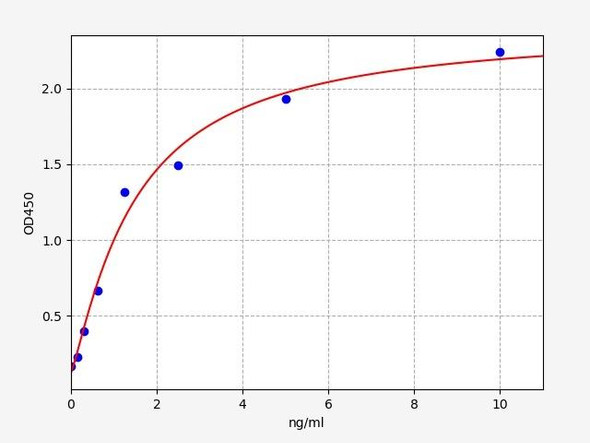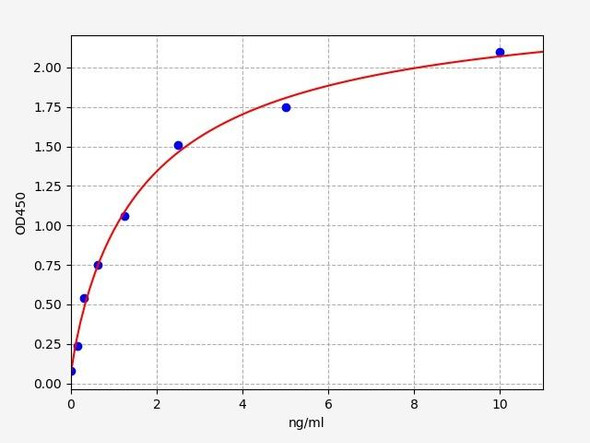Human CD40L / TNFSF5 ELISA Kit (HUFI00076)
- SKU:
- HUFI00076
- Product Type:
- ELISA Kit
- Size:
- 96 Assays
- Uniprot:
- P29965
- Sensitivity:
- 37.5pg/ml
- Range:
- 62.5-4000pg/ml
- ELISA Type:
- Sandwich
- Synonyms:
- CD40L, TNFSF5, TNFSF5, CD40LG, CD154, HIGM1, IGM, IMD3, T-BAM, TRAP, Gp39
- Reactivity:
- Human
- Research Area:
- Cell Biology
Description
Human CD40L/TNFSF5 ELISA Kit
Based on the information provided on the website, the Human CD40L (TNFSF5) ELISA Kit from Assay Genie is a high-quality assay kit designed for the precise detection of CD40L levels in human samples such as serum, plasma, and cell culture supernatants. This ELISA kit boasts exceptional sensitivity and specificity, ensuring accurate and reproducible results for a variety of research applications.CD40L, also known as TNFSF5, is a key protein involved in immune responses and inflammation. It plays a crucial role in the activation of immune cells and the regulation of immune system functions.
Dysregulation of CD40L has been linked to various inflammatory diseases, autoimmune disorders, and cancers, highlighting its importance as a potential biomarker for diagnostic and therapeutic purposes.With the Human CD40L (TNFSF5) ELISA Kit, researchers can effectively measure CD40L levels in human samples, allowing for the study of its involvement in disease processes and the development of targeted interventions. This kit is a valuable tool for advancing our understanding of CD40L biology and its implications for human health.
| Product Name: | Human CD40L / TNFSF5 ELISA Kit |
| Product Code: | HUFI00076 |
| Size: | 96 Assays |
| Alias: | CD40L, TNFSF5, TNFSF5, CD40LG, CD154, HIGM1, IGM, IMD3, T-BAM, TRAP, Gp39 |
| Detection method: | Sandwich ELISA, Double Antibody |
| Application: | This immunoassay kit allows for the in vitro quantitative determination of Human CD40L concentrations in serum plasma and other biological fluids. |
| Sensitivity: | 37.5pg/ml |
| Range: | 62.5-4000pg/ml |
| Storage: | 4°C for 6 months |
| Note: | For Research Use Only |
| Recovery: | Matrices listed below were spiked with certain level of Human CD40L and the recovery rates were calculated by comparing the measured value to the expected amount of Human CD40L in samples. | ||||||||||||||||
| |||||||||||||||||
| Linearity: | The linearity of the kit was assayed by testing samples spiked with appropriate concentration of Human CD40L and their serial dilutions. The results were demonstrated by the percentage of calculated concentration to the expected. | ||||||||||||||||
| |||||||||||||||||
| CV(%): | Intra-Assay: CV<8% Inter-Assay: CV<10% |
| Component | Quantity | Storage |
| ELISA Microplate (Dismountable) | 8×12 strips | 4°C for 6 months |
| Lyophilized Standard | 2 | 4°C/-20°C |
| Sample/Standard Dilution Buffer | 20ml | 4°C |
| Biotin-labeled Antibody(Concentrated) | 120ul | 4°C (Protect from light) |
| Antibody Dilution Buffer | 10ml | 4°C |
| HRP-Streptavidin Conjugate(SABC) | 120ul | 4°C (Protect from light) |
| SABC Dilution Buffer | 10ml | 4°C |
| TMB Substrate | 10ml | 4°C (Protect from light) |
| Stop Solution | 10ml | 4°C |
| Wash Buffer(25X) | 30ml | 4°C |
| Plate Sealer | 5 | - |
Other materials and equipment required:
- Microplate reader with 450 nm wavelength filter
- Multichannel Pipette, Pipette, microcentrifuge tubes and disposable pipette tips
- Incubator
- Deionized or distilled water
- Absorbent paper
- Buffer resevoir
| Uniprot | P29965 |
| UniProt Protein Function: | CD40LG: Mediates B-cell proliferation in the absence of co- stimulus as well as IgE production in the presence of IL-4. Involved in immunoglobulin class switching. Defects in CD40LG are the cause of X-linked immunodeficiency with hyper-IgM type 1 (HIGM1); also known as X-linked hyper IgM syndrome (XHIM). HIGM1 is an immunoglobulin isotype switch defect characterized by elevated concentrations of serum IgM and decreased amounts of all other isotypes. Affected males present at an early age (usually within the first year of life) recurrent bacterial and opportunistic infections, including Pneumocystis carinii pneumonia and intractable diarrhea due to cryptosporidium infection. Despite substitution treatment with intravenous immunoglobulin, the overall prognosis is rather poor, with a death rate of about 10% before adolescence. Belongs to the tumor necrosis factor family. |
| UniProt Protein Details: | Protein type:Membrane protein, integral; Cell adhesion Chromosomal Location of Human Ortholog: Xq26 Cellular Component: extracellular space; integral to plasma membrane; integral to membrane; plasma membrane; external side of plasma membrane Molecular Function:CD40 receptor binding; cytokine activity; tumor necrosis factor receptor binding Biological Process: B cell proliferation; platelet activation; regulation of immune response; leukocyte adhesion; positive regulation of interleukin-12 production; B cell differentiation; immunoglobulin secretion; isotype switching; inflammatory response; regulation of immunoglobulin secretion; negative regulation of apoptosis Disease: Immunodeficiency With Hyper-igm, Type 1 |
| NCBI Summary: | The protein encoded by this gene is expressed on the surface of T cells. It regulates B cell function by engaging CD40 on the B cell surface. A defect in this gene results in an inability to undergo immunoglobulin class switch and is associated with hyper-IgM syndrome. [provided by RefSeq, Jul 2008] |
| UniProt Code: | P29965 |
| NCBI GenInfo Identifier: | 231718 |
| NCBI Gene ID: | 959 |
| NCBI Accession: | P29965.1 |
| UniProt Related Accession: | P29965 |
| Molecular Weight: | 29,274 Da |
| NCBI Full Name: | CD40 ligand |
| NCBI Synonym Full Names: | CD40 ligand |
| NCBI Official Symbol: | CD40LG |
| NCBI Official Synonym Symbols: | IGM; IMD3; TRAP; gp39; CD154; CD40L; HIGM1; T-BAM; TNFSF5; hCD40L |
| NCBI Protein Information: | CD40 ligand; CD40-L; CD40 antigen ligand; T-cell antigen Gp39; T-B cell-activating molecule; TNF-related activation protein; tumor necrosis factor (ligand) superfamily member 5 |
| UniProt Protein Name: | CD40 ligand |
| UniProt Synonym Protein Names: | T-cell antigen Gp39; TNF-related activation protein; TRAP; Tumor necrosis factor ligand superfamily member 5; CD_antigen: CD154Cleaved into the following 2 chains:CD40 ligand, membrane form; CD40 ligand, soluble form |
| UniProt Gene Name: | CD40LG |
| UniProt Entry Name: | CD40L_HUMAN |
*Note: Protocols are specific to each batch/lot. For the correct instructions please follow the protocol included in your kit.
Before adding to wells, equilibrate the SABC working solution and TMB substrate for at least 30 min at 37°C. When diluting samples and reagents, they must be mixed completely and evenly. It is recommended to plot a standard curve for each test.
| Step | Protocol |
| 1. | Set standard, test sample and control (zero) wells on the pre-coated plate respectively, and then, record their positions. It is recommended to measure each standard and sample in duplicate. Wash plate 2 times before adding standard, sample and control (zero) wells! |
| 2. | Aliquot 0.1ml standard solutions into the standard wells. |
| 3. | Add 0.1 ml of Sample / Standard dilution buffer into the control (zero) well. |
| 4. | Add 0.1 ml of properly diluted sample ( Human serum, plasma, tissue homogenates and other biological fluids.) into test sample wells. |
| 5. | Seal the plate with a cover and incubate at 37 °C for 90 min. |
| 6. | Remove the cover and discard the plate content, clap the plate on the absorbent filter papers or other absorbent material. Do NOT let the wells completely dry at any time. Wash plate X2. |
| 7. | Add 0.1 ml of Biotin- detection antibody working solution into the above wells (standard, test sample & zero wells). Add the solution at the bottom of each well without touching the side wall. |
| 8. | Seal the plate with a cover and incubate at 37°C for 60 min. |
| 9. | Remove the cover, and wash plate 3 times with Wash buffer. Let wash buffer rest in wells for 1 min between each wash. |
| 10. | Add 0.1 ml of SABC working solution into each well, cover the plate and incubate at 37°C for 30 min. |
| 11. | Remove the cover and wash plate 5 times with Wash buffer, and each time let the wash buffer stay in the wells for 1-2 min. |
| 12. | Add 90 µl of TMB substrate into each well, cover the plate and incubate at 37°C in dark within 10-20 min. (Note: This incubation time is for reference use only, the optimal time should be determined by end user.) And the shades of blue can be seen in the first 3-4 wells (with most concentrated standard solutions), the other wells show no obvious color. |
| 13. | Add 50 µl of Stop solution into each well and mix thoroughly. The color changes into yellow immediately. |
| 14. | Read the O.D. absorbance at 450 nm in a microplate reader immediately after adding the stop solution. |
When carrying out an ELISA assay it is important to prepare your samples in order to achieve the best possible results. Below we have a list of procedures for the preparation of samples for different sample types.
| Sample Type | Protocol |
| Serum | If using serum separator tubes, allow samples to clot for 30 minutes at room temperature. Centrifuge for 10 minutes at 1,000x g. Collect the serum fraction and assay promptly or aliquot and store the samples at -80°C. Avoid multiple freeze-thaw cycles. If serum separator tubes are not being used, allow samples to clot overnight at 2-8°C. Centrifuge for 10 minutes at 1,000x g. Remove serum and assay promptly or aliquot and store the samples at -80°C. Avoid multiple freeze-thaw cycles. |
| Plasma | Collect plasma using EDTA or heparin as an anticoagulant. Centrifuge samples at 4°C for 15 mins at 1000 × g within 30 mins of collection. Collect the plasma fraction and assay promptly or aliquot and store the samples at -80°C. Avoid multiple freeze-thaw cycles. Note: Over haemolysed samples are not suitable for use with this kit. |
| Urine & Cerebrospinal Fluid | Collect the urine (mid-stream) in a sterile container, centrifuge for 20 mins at 2000-3000 rpm. Remove supernatant and assay immediately. If any precipitation is detected, repeat the centrifugation step. A similar protocol can be used for cerebrospinal fluid. |
| Cell culture supernatant | Collect the cell culture media by pipette, followed by centrifugation at 4°C for 20 mins at 1500 rpm. Collect the clear supernatant and assay immediately. |
| Cell lysates | Solubilize cells in lysis buffer and allow to sit on ice for 30 minutes. Centrifuge tubes at 14,000 x g for 5 minutes to remove insoluble material. Aliquot the supernatant into a new tube and discard the remaining whole cell extract. Quantify total protein concentration using a total protein assay. Assay immediately or aliquot and store at ≤ -20 °C. |
| Tissue homogenates | The preparation of tissue homogenates will vary depending upon tissue type. Rinse tissue with 1X PBS to remove excess blood & homogenize in 20ml of 1X PBS (including protease inhibitors) and store overnight at ≤ -20°C. Two freeze-thaw cycles are required to break the cell membranes. To further disrupt the cell membranes you can sonicate the samples. Centrifuge homogenates for 5 mins at 5000xg. Remove the supernatant and assay immediately or aliquot and store at -20°C or -80°C. |
| Tissue lysates | Rinse tissue with PBS, cut into 1-2 mm pieces, and homogenize with a tissue homogenizer in PBS. Add an equal volume of RIPA buffer containing protease inhibitors and lyse tissues at room temperature for 30 minutes with gentle agitation. Centrifuge to remove debris. Quantify total protein concentration using a total protein assay. Assay immediately or aliquot and store at ≤ -20 °C. |
| Breast Milk | Collect milk samples and centrifuge at 10,000 x g for 60 min at 4°C. Aliquot the supernatant and assay. For long term use, store samples at -80°C. Minimize freeze/thaw cycles. |






